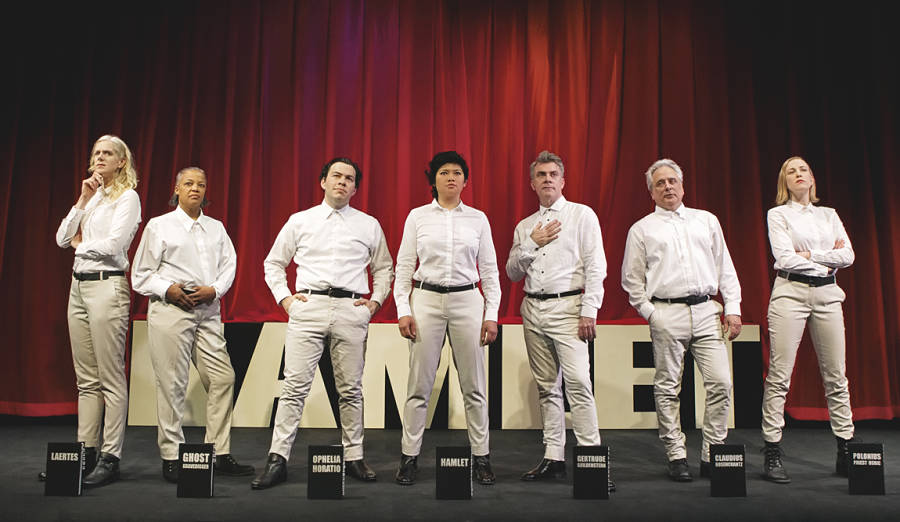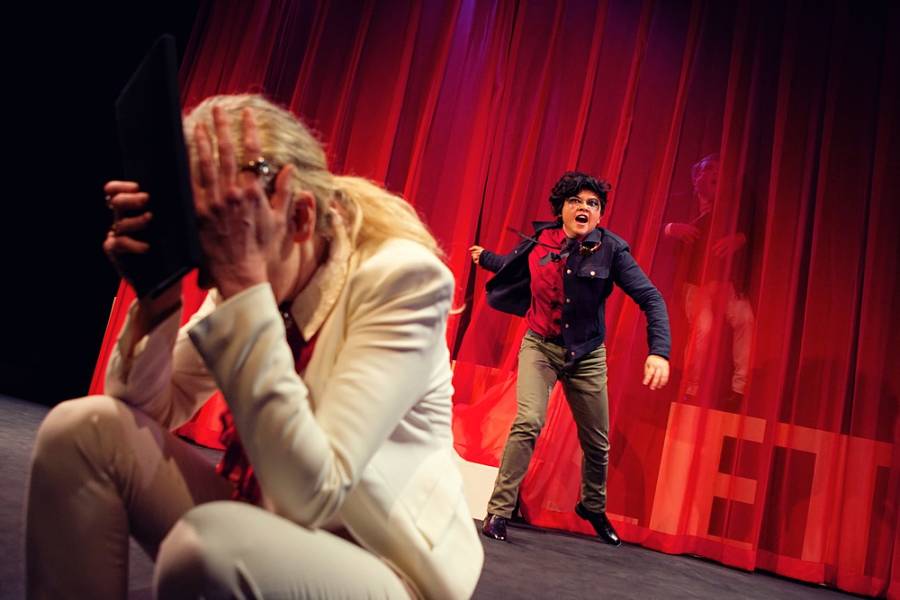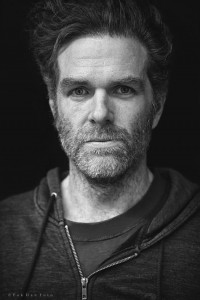On the first night of previews, Megan Trout was nervous. That’s understandable, of course, for any lead actor in a play, especially when the role is Hamlet. Trout found the moments before the show started at Shotgun Players in Berkeley, Calif., especially “terrifying and exhilarating” because, she says, “I did not feel 100 percent prepared for the part, which felt really abnormal.”
It’s not that Trout is a slacker. It’s that she had no way to be completely certain about all her lines and blocking that night. Trout, along with her six cast mates, had thrown caution—and perhaps their sanity—to the wind when they signed on for Hamlet Roulette, an ambitious experiment concocted by director Mark Jackson and Shotgun artistic director Patrick Dooley. Each performer had learned Hamlet’s part as well as those of Claudius, Gertrude, Laertes, Horatio, and, well, everyone. And it was only moments before the first scene that Trout found out that she would play Hamlet that night.
That’s because each night during the show’s run (Mar. 31–May 8), the cast stands before the audience dressed in white. Each actor reaches into Yorick’s skull and finds out on the spot which parts he or she has that night. On the second night of previews, Trout doubled as Gertrude and Guildenstern; El Beh, who played those roles the first night, played the melancholy Dane in the third preview. (Five of the seven actors double in two roles.) While Tom Waits’s “Satisfied” plays, the cast has about four minutes to scamper off, grab their costumes, and ready themselves.
“The show is radically different every night, and you don’t really get it until you’ve seen it multiple times,” Dooley says.
“It really makes you appreciate how many possibilities there are for this play,” Jackson says, adding that having seven different Hamlets with a new alignment in the supporting roles each night “made us rethink everything about what we do and how we communicate with the audience.”

A friend of Jackson’s supplied the initial idea. He recalled a comment of Steven Berkoff’s after a reviewer declared him “miscast” in Hamlet: “Every actor is right for Hamlet,” Berkoff reportedly said, “because there is something of Hamlet in every human being.”
Dooley says that while the cautious and meticulous Jackson thought the notion unwieldy, Dooley was unstoppable. “I jump first and think later—in 7th grade I ran a marathon on a whim with no training…in cut-off jeans.”
His “dumb but willful” attitude finally prevailed. As Shotgun is celebrating its 25th anniversary with a repertory season, he persuaded Jackson that kicking off with the “chaos rep” of Hamlet Roulette would be perfect.
Casting was the first challenge. Dooley and Jackson wanted a cast that reflected their diverse community and ended up with four women and three men of varying ages, ethnicities, and sexual orientations. “When a white guy as Hamlet pushes an African-American woman as Ophelia up against a wall, everything changes,” Jackson says. “The actors respond differently based on who they are, so you don’t have to do much to make it different every night.”
Adds Dooley, “And when you have Ophelia’s mad scene being played by man who is almost 60—and we do it seriously, not campy– it is a little ridiculous but it is also beautiful.”
Casting wasn’t just about checking the right boxes, though, or even having the right skills. Dooley says that “mental toughness” mattered as much as chops, especially since this Hamlet would eventually be in rep with The Village Bike, Who’s Afraid of Virginia Woolf?, among other plays. He and Jackson say they did “background checks” to find out how their prospective actors handled tech week, what they were like backstage late in a run, how they handled stress. “They had to be dynamic actors, but we needed marathoners who would be there for each other,” he says. “If they didn’t take the magnitude of the challenge seriously enough—that everything else in their life would have to become No. 2—that was a red flag.”
Additionally, Jackson says, “Everybody had to be just a little bit crazy.”
The first step last summer was cutting the play from four hours to two-and-a-half. Jackson made the editing job a full-cast project. “Looking at the play through all those lenses could have been a huge shitshow, but it was not,” says Beh.
The doubling decisions felt natural: Horatio and Ophelia both love Hamlet, Polonious and Osric are comic foils, the Ghost and the gravedigger are both connected to death. The group decided to strengthen both Gertrude and Ophelia, giving the latter some of Laertes’ lines in one of their scenes and cutting the Players, and instead having the play within the play done by Hamlet and Ophelia. “It gives her more of a fighting edge,” Trout says.
“Her nunnery speech comes out of love for Hamlet now, and she doesn’t seem as victimized,” Beh says.
Then the cast had to start learning their parts—all of them. “I was excited, but I wasn’t thinking about the practical details,” Trout says. “Nothing prepares you for memorizing the whole play, blocking each scene from every character’s perspective.”
Trout and Beh both started off memorizing scene by scene, though Trout says she switched to character by character once rehearsals started. She recorded herself doing the whole play and would listen “while doing laundry or walking to work.” Beh confesses, “I was talking to myself constantly, on my bike or in the shower.”
Beh felt overwhelmed. “I told myself at one point I’d learn two pages a day, but the stress was so much that I was putting in the hours but my brain was not absorbing the words,” she says, adding that the support from her cast members relaxed her and eventually the words sank in.
Jackson also struggled, looking for coherent ways to run rehearsal. He created “round robins” where the actors would pull names out of a hat for each role and do a scene, give notes, and then rotate, and an approach called “schizoiding,” in which two actors handled one part, with one doing the lines and one developing the movements until they eventually combined forces and took on both words and action collectively.
The women’s initial concerns about Jackson’s communal approach were quickly overcome. “I worried about not having creative agency, but Mark developed a template for the blocking and allowed us to come up with variations,” Trout says.
“We decided things collectively, but there was always wiggle room,” Beh says. “I’ve decided to play Gertrude as if she knows almost everything about what Claudius did, but some have decided she does not know anything.”
Jackson also decided to have each actor carry the script onstage, even using it as a prop (for instance, it is the Gravedigger’s shovel). This acknowledgment of theatrical artifice, Trout says, “makes a play that’s intimidating to audiences more relatable.”
They also decided that Laertes would not be doubled and would instead sit offstage ready to feed lines to anyone who needed help. Additionally, if an actor completely blanked, going up for more than just a few words, he or she could say, “Take it,” and Laertes would read a longer stretch while the onstage actor performed the movements, putting the “schizoiding” technique to good effect.
“Mark was meticulous with backup plans to his backup plans’ backup plans,” Trout quips. “Still, it was a fraught process and everyone had a breakdown moment in rehearsal, where they reached capacity. We’d have a moment of panic and ask, ‘How are we going to do this?’”
Dooley realized that seven weeks of rehearsals and seven previews would not be enough, so he extended both. “As unbelievably hard as it was to learn all the lines, the backstage staging and costume changes was much more to absorb,” he says. “Then afterward, you had to read notes for every role.”
Additionally, he and Jackson decided that tech and previews would not have completely random casting. “We had a perverse fantasy of someone not getting to play Hamlet till closing night next year,” Jackson says, but Dooley says as previews approached the actors decided that joke was not funny.
“We had to talk them off the ledge,” he says, creating a system by which everyone would play each role during tech and previews; in tech actors had the choice of knowing or not knowing which they were to play beforehand.
Trout says she wanted to know because she wanted to prepare each night to get that role right, while Beh didn’t want to know. “I wanted only one fuckfest at a time,” Beh reasons. “I did not want my first time with an audience in previews to also be my first time not knowing what role I’d have. That would have been too much.”
The first preview was for an audience of students. Trout went up on her lines just twice, both for the simplest of phrases, “Aha,” and “I am dead, Horatio,” the latter request inspiring laughter that cut the tension of the fight’s climax.
Trout says she wishes she could have had another shot at Hamlet the next night. “I felt if I could have had one more go I would have done even better, and now I don’t know when I’ll be Hamlet again,” she says. “I now realize repetition is such a luxury in the theatrical process.”
Dooley said there were fewer calls for lines on the second night, but that wasn’t necessarily a good thing. “They seemed more cautious, as if they were making sure to say the words instead of throwing themselves at the wall,” he says. “But by the third night they were back at it.”
He says audience members began making return visits almost immediately and were duly rewarded. “Megan is a competitive gymnast and a super physical actor, so her Hamlet makes a different show than Nick Medina, who is more cerebral.”
“I think I’m a really intense Hamlet,” Beh says, adding that the audience becomes more contemplative for a thoughtful Hamlet or more energized for a more manic protagonist. “They ride the energy,” she says. Either way, Beh says, she hopes audiences “find a little messiness exciting.”
Jackson says they are responding. “The whole first show was a bit of a trainwreck, but we got a standing ovation,” Jackson says. “People want something authentic and alive at the theatre. They want to see there’s a real risk someone will fail—and when you do, the audience is on your side because they see how hard this is and they see you get back up and keep going.”



